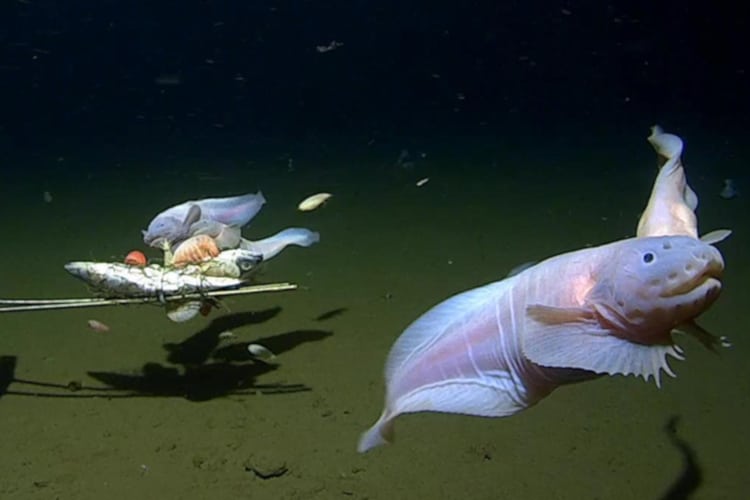
Photo: Minderoo-University of Western Australia Deep Sea Research Centre
Researchers have seemingly been exploring the ocean forever, yet there is still so much unknown within its depths. There are always new creatures being discovered and mysteries being unveiled. Just recently, a team of scientists from the University of Western Australia and the Tokyo University of Marine Science and Technology have broken a record by filming the world's deepest fish, which lives in the depths of the Izu-Ogasawara Trench off the coast of Japan at a staggering 8,336 meters (about 27,329 feet).
The unknown snailfish in the footage belongs to the genus Pseudoliparis. It has the appearance of a light-colored, large tadpole with fins on the side. These snailfish do not have any scales nor a swim bladder, unlike other fish species. The lack of the latter feature allows them to live under the extreme pressure of the deepest parts of the trench.
On top of discovering the deepest fish ever caught on camera, the scientists also captured two Pseudoliparis belyaevi snailfish with the help of traps set at a depth of about 8,022 meters (26,319 feet). According to a press release from the University of Western Australia, this the first time that fish have been caught at a depth of more than 8,000 meters (26,247 feet) with the help of “baited cameras.”
The Izu-Ogasawara is not as deep as the more popular Marianas Trench, where not that many creatures have been found at the 8,000-meter mark compared to the abundance of fish in the Izu-Ogasawara Trench. “In other trenches such as the Mariana Trench, we were finding them at increasingly deeper depths just creeping over that 8,000-meter mark in fewer and fewer numbers, but around Japan they are really quite abundant,” said Professor Alan Jamieson of the Minderoo-UWA Deep Sea Research Centre, who led the expedition.
“The Japanese trenches were incredible places to explore; they are so rich in life, even all the way at the bottom. We have spent over 15 years researching these deep snailfish; there is so much more to them than simply the depth, but the maximum depth they can survive is truly astonishing.”
In an interview with IFL Science, Jamieson explained that while the immense pressure of the depths does shape life in these environments, there are other factors at play. “Everyone thinks that depth is the most important thing in these trenches,” Jamieson states. “Temperature can also be important.” Since the bottom of the Marianas Trench is colder due to it being closer to the Southern Ocean, fish don't thrive at these depths the way they do in the Izu-Ogasawara Trench. “If someone finds fish at greater depths, it won't be by much,” the researcher postulates.
These findings were the result of a 10-year study into the fish population in the depths of the Izu-Ogasawara Trench. “The real take-home message for me,” Jamieson says, “is not necessarily that they are living at 8,336 meters but rather we have enough information on this environment to have predicted that these trenches would be where the deepest fish would be, in fact until this expedition, no one had ever seen nor collected a single fish from this entire trench.”
A team of scientists have broken a record by filming the world's deepest fish, which lives in the depths of the Izu-Ogasawara Trench off the coast of Japan at a staggering 8,336 meters (27,329 feet).
University of Western Australia: Website | Facebook
h/t: [Gizmodo]
Related Articles:
World’s Oldest Preserved Brain Found in a 319 Million-Year-Old Fish Fossil
Giant Goldfish Weighing Nearly 70 Pounds Is a Good Reminder to Not Release Your Pets
Scientists Uncover Key Gene of the Immortal Jellyfish That Makes Them Immortal
This Rainbow Fish Is Born Female and Becomes Male As It Ages






















































































